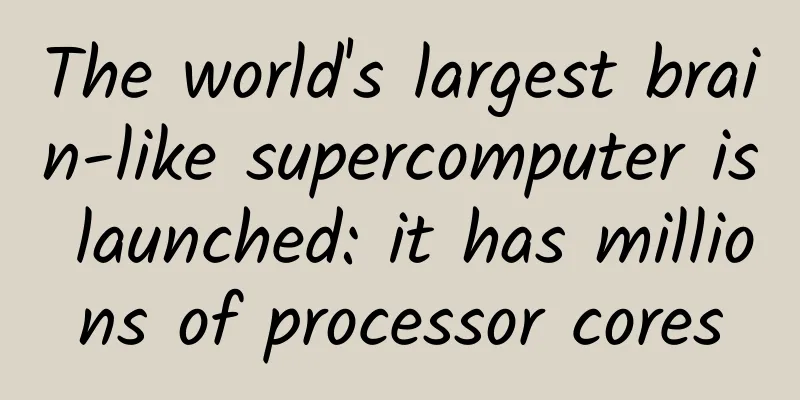The world's largest brain-like supercomputer is launched: it has millions of processor cores

|
Image: This UK supercomputer can operate like the human brain (Original title: This new supercomputer is now the world's fastest brain-mimicking machine) On November 6, according to foreign media reports, scientists recently activated the world's largest "brain": a supercomputer with 1 million processor cores and 1,200 interconnected circuit boards, which works in the same way as the human brain. Scientists announced that this is the world's largest neuromorphic computer, that is, a computer that simulates the discharge of neurons. The supercomputer, called the Spiking Neural Network Architecture (SpiNNaker), is based at the University of Manchester in the U.K. It "reimagines the way traditional computers work," project member Steve Furber, a professor of computer engineering at the university, said in a statement. But SpiNNaker does more than just “think” like a brain. It creates models of neurons in the human brain and simulates more neurons in action in real time than any other computer on Earth, according to the announcement. “Its main task is to support partial models of the brain: for example, models of the cortex, the basal ganglia, or multiple regions represented as networks of spiking neurons,” Furber said. More processors Ferber explained that SpiNNaker has been using 500,000 core processors to simulate neuronal activity since April 2016, but the upgraded machine has twice the capacity. With support from the European Union's Human Brain Project, SpiNNaker will continue to enable scientists to build detailed models of the brain. Now SpiNNaker has the ability to perform 200 trillion operations simultaneously, Ferber said in a statement. While some other computers may match SpiNNaker in terms of processor count, what makes this supercomputer unique is the infrastructure that connects those processors. In the human brain, 100 billion neurons fire simultaneously and send signals to thousands of target neurons. SpiNNaker's architecture supports ad hoc communication between processors, which behaves much like the brain's neural networks, Furber explained. “The connections of traditional supercomputers are not suitable for modeling the brain in real time,” he said. “I believe SpiNNaker can simulate larger neural networks in real time than any other machine.” Computer-based thinking simulation Before this, SpiNNaker could only run on 500,000 processors and model 80,000 neurons in the cerebral cortex. Another SpiNNaker simulation study of the basal ganglia, a brain region affected by Parkinson's disease, confirmed the potential of computers as a tool for studying brain diseases. SpiNNaker can also control a mobile robot called SpOmnibot, which uses a computer to interpret data from the robot's vision sensors and make navigation choices in real time, Furber said. So, with all its computing power and ability to simulate the brain, how close is SpiNNaker to a real human brain? Furber said that it is impossible to fully simulate the human brain at present. Advanced machines like SpiNNaker can still only handle a small part of the communication of the human brain, and supercomputers still have a long way to go before they can think independently. “Even with a million processors, and making a lot of simplifying assumptions, we’re only getting to 1 percent of the size of the human brain,” he said. However, Ferber added that because the mouse brain is 1,000 times smaller than the human brain, SpiNNaker can mimic the functions of the mouse brain. “If the idea of a mouse is just based on wiring up enough neurons in the right structure (which is controversial in itself), then the model we currently have running on SpiNNaker can get to that level,” Furber said. |
>>: Five packet sniffers that can replace Wireshark
Recommend
5G network deployment brings both opportunities and challenges
5G (or 5th generation mobile networks) deployment...
edgeNAT July Promotion: 20% off for monthly VPS and 30% off for annual VPS starting from 48 yuan/month, available in China, Hong Kong, and South Korea
edgeNAT has launched a promotion for this month. ...
5G has great potential in promoting the development of industrial Internet!
[[412406]] As an industry that deeply integrates ...
IT Viewpoint: Five major network challenges for 2019
Frank Scalzo, network director at data center ope...
Thoroughly understand cross-domain issues SpringBoot helps you unimpeded
Environment: SpringBoot2.7.16 1. Introduction Cro...
How does private 5G impact Industry 4.0 transformation?
Private 5G networks have become very popular as r...
After 5G, four wireless technologies worth paying attention to
5G NR is a complex of contradictions. It is diffi...
Miss 5G's "Martial Arts Competition to Win a Husband"
Xiao Z: Ladies and gentlemen, welcome to our Miss...
Is 5G connectivity the future of IoT?
The three major US mobile operators AT&T, T-M...
my country's industrial Internet platform construction faces four major bottlenecks
The Guiding Opinions of the State Council on Deep...
HostDare: 35% off KVM in Los Angeles, starting at $25.99/year
HostDare is a foreign VPS hosting company founded...
Improving time efficiency and accuracy: Carrier routing network mining
1. Introduction The fulfillment time is the lifel...
Can 6G technology directly skip 5G technology?
1G→5G: There is precedent for skipping As far as ...
Do you know how to use a switch? The correct way to connect a switch
In the era of popular Internet, many families hav...
Detailed discussion of RDMA technology principles and three implementation methods
[[385738]] Remote Direct Memory Access (RDMA) is ...






![[Black Friday] TMThosting: 30% off monthly payment for Seattle high-security VPS, 10% off for dedicated servers, supports Alipay](/upload/images/67cac02248693.webp)


